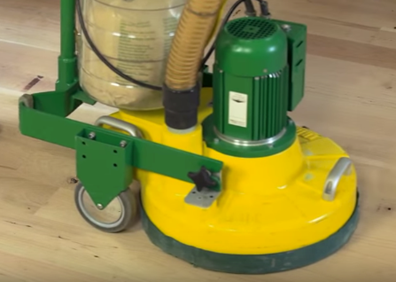Refinishing your hardwood floors is always less expensive than replacement. Installing new hardwood floors includes the hardwood and the labor to remove the old floor. Then, add on the installation and finishing costs. Refinishing your existing floor can reset the finish at a fraction of the cost. The top layer of the hardwood flooring is the defensive barrier that protects the wood from damage and wear. Knowing when and how to sand your floor will be the difference between replacement and enhancement.
Sanding
Sanding prepares the hardwood floors for refinishing. During the sanding process minor scratches and dents can be removed. Gray floorboards and splinters indicate that replacement would be a better option. If your floors have the following issues, consider refinishing your hardwood floors.
- Water damage
- Major scratches, dents, or gouges
- Fading and discoloration from the sun
- Impossible to remove stains
When to sand
The thickness of the floor determines the amount of sanding that can be done. For a ¾ inch floor, sanding 4 to 6 times is the limit. Every 7 to 10 years are a good target for Hardwood Floors.
Sanding ensures that the new finish soaks into the wood evenly. The exterior and interior temperature should be between 65 to 75 degrees for optimum curing of the finished floor. If summer is dryer than spring, wait until summer to refinish floors. Humidity will prolong drying time.
If your floors’ finish was applied before the 1970s, it was before polyurethane was used as a sealant. The floor is coated with wax, old-fashioned varnish, or shellac. If you do have wax, you still don’t have to sand for a clean and shiny finish. Consider buffing on a fresh wax coat to get shine, albeit temporary, as well as to continue protecting your floors from wear and tear. Varnish and shellac will have to be sanded away.
In the case of water damage or pet stains that have penetrated through the finish to the actual flooring, a new coat of finish will not hide or remove these spots. The optimal way to remove these unsightly stains is through sanding.
Chemical Agents
Refinishing floors using a chemical agent is less effective than sanding. Using chemical abrasives instead of sanding is a considerable amount of work. Chemical abrasives may include store-bought chemical abrasion kit, buff agent prior to recoating floors with polyurethane, or a revitalizer. These chemicals involve a considerable amount of sweat-equity and ventilation.
Recapturing the hardwood aesthetic is best done through sanding and refinishing. The refinishing can reflect the design aesthetic of the contemporary times in color, sheen, and feel. However, too much sanding can wear the hardwoods down until they are too thin. Cracks will appear if the wood is not structurally sound. Replacement of Hardwood Floors is the only option when this occurs.
Dustless Sanding
The dustless process captures 99 percent of the dust created in sanding the hardwood floors. This benefits the refinishing process by streamlining the clean up required before the first board can be stained. This also benefits vulnerable populations in hospitals or nursing homes. The low dust factor benefits asthmatics and people with other breathing disorders.
Installer
Hudson Floor Group Inc. does dustless sanding. Hardwood Floors are a major investment. Hudson Floor Group Inc. is a full-service flooring company providing installation, refinishing, restoration, repairs, maintenance, flooring material and high quality, professional service. Contact us at info@hudsonfloorgroup.com OR phone us at 201-644-4400. NJ Location: 92 Bell Street Orange, NJ 07050 NYC Location: 244 Fifth Avenue, Suite Q291 New York, NY 10001. CERTIFICATIONS: OSHA, NWFA, and FSC.

